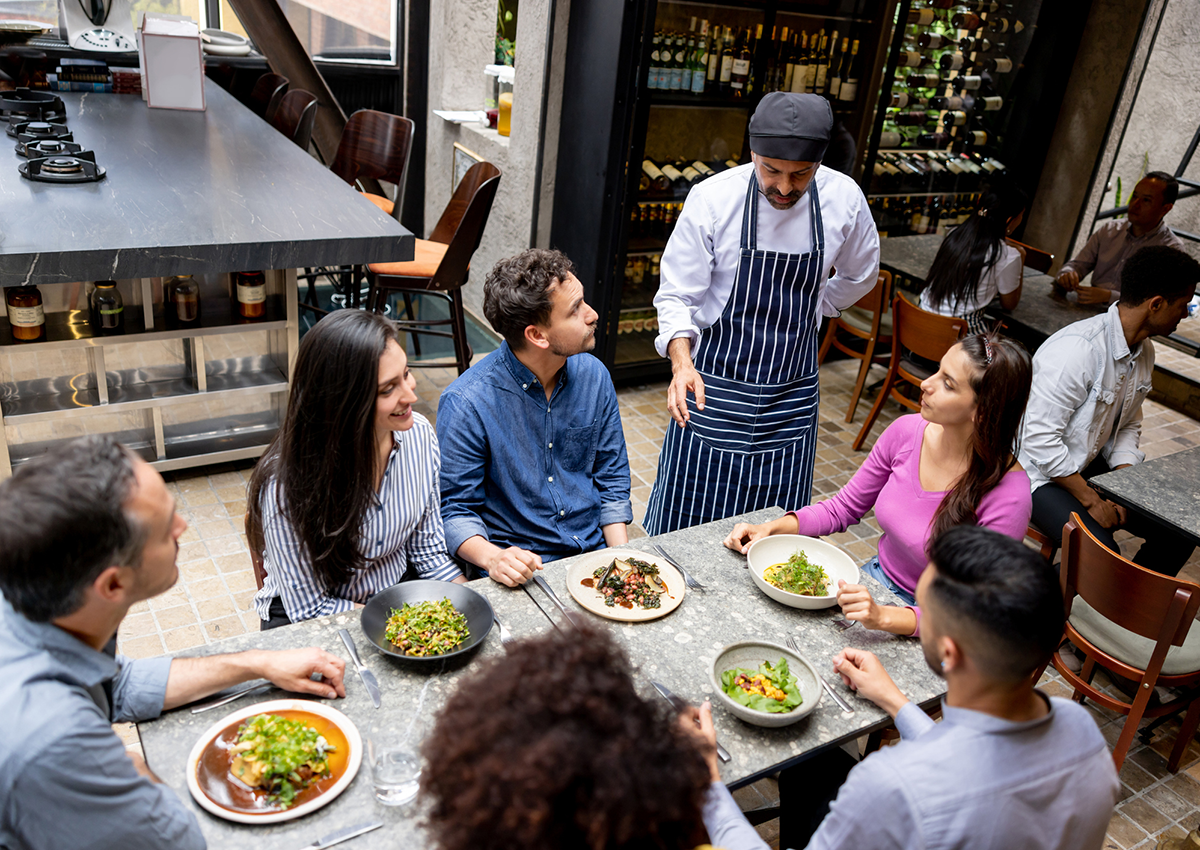In the past, generic loyalty programs were enough to encourage customer engagement. However, times have changed, and guests expect more from restaurant loyalty apps than ever before.
In order to remain relevant in the highly competitive restaurant industry, your loyalty program needs to stand out from the crowd. Targeted solutions–focused on the right customers–can significantly boost brand loyalty and encourage repeat business. If you feel like your loyalty program isn’t drawing the attention of certain segments you’d like to reach, you’re in the right place.
Join us to learn how to target the best customers for your restaurant loyalty program and learn to engage with segments that might currently be out of reach.
We’ll cover:
Key targeting criteria for restaurant loyalty programs
Your restaurant’s POS data can offer a lot of information about your clientele and give you an idea of which segments you’re missing out on. Although demographics were once considered the beginning and end of customer segmentation, they’re now considered only a starting point for understanding your guests.
Here’s a closer look at the many ways to differentiate your customer base.
Demographic targeting
Basic information such as age, location, and marital status can help you identify some of your customers’ key traits.
Marketing pros have long touted the benefits of personalization in increasing engagement and building relationships with clients. Compared to one-size-fits-all approaches, targeted marketing helps your guests feel seen and heard, making them more likely to buy and more likely to return.
For example, Gen Z consists of people born between 1997 and 2012. These so-called digital natives have always had easy access to technology and, consequently, have become resistant to impersonal advertising strategies. In fact, about half of those surveyed for the Twilio Segment 2023 State of Personalization Report say they’re less likely to shop with a business after an “impersonal experience.”
Additionally, this group is also less likely to jump on time-sensitive offers than their Millennial counterparts.
When you have this information at your fingertips, you can cater your restaurant loyalty program to your existing demographics and tweak it to meet the needs of other segments.
Behavioral targeting
In addition to demographics, consumer behaviors can give you another way to engage with established customers and recruit new ones. Dining frequency, average check size, and menu preferences reveal your guests’ habits and show you what visitors are looking for in a loyalty program.
Consider the ordering methods your business offers. What percentage comes from customers who dine in, call, and place orders online? Can your guests place orders through your online ordering systemrestaurant loyalty app? If not, you could be missing out on a major revenue opportunity. After all, when you remove the barriers to ordering, such as placing a phone call, relying on analog payment methods, and inputting payment information, you increase your chance of making a sale.
Studies show that the number of people placing orders through loyalty apps is on the rise, and it doesn’t show any signs of slowing down. Allowing your customers to save their favorite orders, store payment methods, and order with the swipe of a finger–along with offering enticing incentives–puts you ahead of the competition, especially those who aren’t leveraging technology to their advantage.
Psychographic targeting
Psychographic segmentation can help business owners understand the “why” behind their customers’ choices. This method considers personality traits, personal preferences, and the psychological foundations of certain decisions to categorize guests by interests, lifestyle, and so on. While this might sound abstract and intangible, it’s easy to nail down when you know what you’re looking for.
For example, psychographic targeting might be geared toward those with specific dietary preferences, like vegetarians and gluten-free guests. You might make special offers to particularly adventurous eaters or those who value experiences over monetary rewards. Additionally, you can narrow your focus to appeal to value-conscious diners who want to make a difference with every dollar they spend.
While the data from your restaurant’s POS system can help you identify some of these characteristics, such as dietary preferences, others might require trial and error. Quizzes offered through your loyalty app and social media platforms can provide some answers. However, it’s also wise to do market research on specific sectors. After all, there’s a high rate of overlap between different demographic and psychographic segments, which can give you better insight into your customers.
The power of values-driven loyalty in restaurants
Consumers are becoming more value-driven than ever before, and restaurants should be prepared to rise to the occasion.
Cause-focused programs
About half of all consumers consider themselves value-oriented and prioritize purchases they see as good for people, personal health, animals, and the planet. And 80% of these shoppers are willing to pay a premium for sustainable, mindfully procured products.
Your restaurant loyalty programapp can help your guests give back and allow them to see your contributions to important causes. Consider establishing a sustainability initiative where customers can bring in reusable containers in exchange for bonus points or other rewards. You might also partner with local charities by donating food or money as your customers rise in the ranks. Some businesses even allow members to donate points to benefit a good cause.
Building community
Restaurant loyalty apps can–and should–offer more than just discounts to their faithful followers. Your guests should feel like valued members of your community, and there are many ways to foster that feeling.
You might allow members to earn badges as they meet milestones like number of visits, trying exotic menu items, and engaging in community forums by leaving positive reviews and recommendations. Consider offering access to “secret” menus as your customers ascend the tiers of your loyalty program. As they unlock more exclusive content, they’ll be motivated to continue the journey to VIP status.
Unique experiences as rewards
Take community-building to the next level by hosting members-only events for customers at the highest levels of your restaurant loyalty program. These might include cooking classes, chef’s table access, or priority reservations to show your appreciation for their business.
You can also partner with local businesses to offer joint experiences customers can’t access without your loyalty program. For example, you might host a “club crawl” where upper-tier members start with snacks at your restaurant, hit a nearby bar for a cocktail tasting, and cap off the evening with dessert and coffee at a local cafe.
Many consumers are driven by FOMO, or the fear of missing out. They’re more likely to bite when they know exciting experiences are at stake. In particular, Gen Z, Millennials, and Gen X tend to prioritize experiential rewards more than other segments of the population. You won’t want to overlook this concept if you’re hoping to gain more traction with these guests.
Case studies: Restaurants winning with targeted loyalty
Looking for a little inspiration for your restaurant loyalty app? Here are a few businesses that have cornered the market on targeted loyalty.
The family favorite
Beloved ice cream chain Cold Stone Creamery offers rich, decadent scoops with tons of mix-in options. Customers can create their own masterpiece every time they visit, and Cold Stone’s restaurant loyalty app only sweetens the deal.
When you sign up, you’ll automatically get a “Buy One Get One Free Creation” as well as another BOGO deal for your birthday. Every dollar spent gets you another point, and those points automatically become $5 coupons once you reach 50 (which won’t take too long since you also get 25 just for signing up).
Best of all, you can keep the whole family–up to seven members–on a single account. Since children often rely on their parents’ memberships for access, this allows you to add everyone’s birthday so no one misses out! Plus, everyone can rack up points to earn freebies.
The “foodie” hotspot
National restaurant chain PF Chang’s is known for its eclectic Asian-fusion menu, and their loyalty app makes it easy to earn rewards and find your new favorite menu items.
First, you’ll get 1,000 points just for signing up. Then, you’ll earn ten points for every dollar you spend. Every time you reach 2,000 points, you’ll get a $15 reward.
But that’s not all!
This loyalty program allows members to take quizzes to discover new menu items they might enjoy. The quiz also asks about food preferences and general interests to better understand you as an individual and cater each and every experience to your liking.
The local gem
Farmer Boys restaurant chain is a West Coast favorite featuring burgers, wraps, salads, sandwiches, and more. However, what sets them apart is their commitment to locally sourced ingredients. They opened their first location in 1981, and today, they have 100 restaurants in California and Nevada.
Their loyalty program helps members (also known as Very Important Farmers) earn points towards free food with every purchase. You get one point for every dollar spent, which you can trade in at different levels. They also offer opportunities to earn double points, birthday bonuses, and exclusive members-only deals. You can even get bonus points for referring a friend.
Customers can feel great about racking up points, as they know the money they spend goes back to the local community.
When your ideal customer isn’t so obvious
Veggie Grill, a plant-based restaurant with locations on the East and West Coasts, had no problem recruiting vegetarian and vegan customers. However, they managed to corner a larger segment of the consumer market to capture the interest of folks in many areas of the health and wellness spheres.
The Veggie Grill restaurant loyalty app gives members statuses, such as Health Hero and Planet Protector, which reinforce the mindset of holistic wellness. Members get points for every purchase, as well as information like how much water they’ve saved along the way to VIP status.
The company has also sponsored a series of wellness retreats and food festivals celebrating fresh, wholesome ingredients. These events have attracted more like-minded members who aren’t necessarily plant-based but care about the same values as Veggie Grill.
Remember, adaptability is key! As you analyze the data and refine your restaurant loyalty program, you’ll find new and exciting ways to reach more customers outside of your apparent demographic.
Tools and strategies
Modern, cloud-based POS systems with integrated restaurant loyalty programs offer a wealth of information about your customers. Purchasing habits, menu preferences, visit frequency, and other data points can help you know what your guests want from their dining experience so you can have it ready and waiting before they walk through the door.
Your restaurant’s data collection process may have started with simple sales reports at the end of the day. If you’ve already implemented a state-of-the-art POS system, then you’ve already advanced to gathering more detailed information. Your restaurant loyalty app takes things to the next level by giving you a direct line of communication with your customers and the ability to target your marketing efforts to individual patrons.
Utilizing a tier-based points system in your restaurant loyalty program allows you to cater to customers at different levels of spending and engagement. For example, members at higher tiers might earn more points per dollar spent and get access to more exclusive events and insider info than baseline members.
Of course, some restaurants opt for pay-to-play loyalty programs that feature high-end rewards, free prix fixe dinners, and other experiences that non-members can’t access.
Conclusion
Targeted loyalty programs drive long-term restaurant success by fostering deeper customer relationships. While individual guest rewards are the foundation of this dynamic, loyalty programs go beyond points by positioning your establishment as part of the community, offering unique experiences, and showcasing your values as a company.
The right POS system can allow you to take your restaurant rewards program above and beyond. When you have the ability to understand your customers on a deeper level–through their behaviors and preferences–you can cater each experience to meet their needs.
Check out CAKE’s restaurant loyalty solutions or request a free demo to see how we can help you find the best customers for your restaurant loyalty program!







